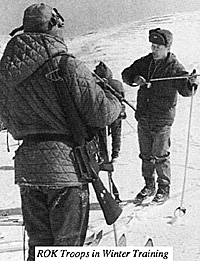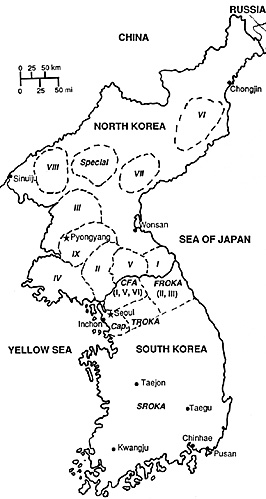
Environment
The Korean peninsula is mainly rugged and unforested hill terrain with low mountains and steep-sloped narrow valleys. Nearly every piece of flat terrain has been cultivated as rice paddy. About half of the annual rainfall occurs during the summer monsoon (June-September), which is hot and humid.
At this period, and during all except the coldest winter months, off-road trafficability is very poor because of the boggy condition of the paddies. Visibility is predominantly good in the spring and fall, but in winter about 40% of the days are marginal to poor for ground support aircraft using purely visual systems (i.e. the North Koreans). Winter tends to be long, cold, and dry, with snow accumulations increasing as one goes north. Hills are bare of the short brushy vegetation which exists during spring through fall.
In the December- February time frame, temperatures average in the teens to the low twenties (and dip below zero (Fahrenheit), allowing armored vehicles to maneuver over paddies.
During the 1950 offensive, tanks played a large part in the North Korean success. Although this was a summer attack, the tanks could remain on roads for the most part because of the nearly complete lack of effective anti-tank weaponry in the ROK Army. Today the ROKs have good anti-tank systems, if not many of them, and a lot of fortifications and barriers. Thus, logically, a North Korean attack that could make full use of the NKPA's hordes of armor, must be launched in the winter when the tanks will not be road-bound.
Of course, there is always the chance that this would not be the case - logic not being a strength of Kim Il Sung's regime...
 Forces
Forces
The North Koreans have amassed a military machine which appears truly formidable. Their 3,500 tanks have the ROKs outnumbered about 2.25 to 1; their 4,200 armored personnel carriers by about 2 to 1; and their 8,100 guns and multiple rocket launchers by 2 to 1 as well.
Organized into 15 corps (six of which are armored or mechanized), the NKPA boasts two armored divisions, ten mechanized divisions (with more being mechanized), 26 infantry divisions (many motorized or semi-motorized), 26 reserve infantry divisions (cadre in peace), ten separate tank brigades or regiments, three marine brigades, four reconnaissance brigades, five combined arms assault brigades, ten light infantry (unconventional warfare) brigades, and four airborne capable brigades.
The NKPA keeps the majority of its forces in close proximity to the DMZ, with much of their equipment protected in underground shelters. Heavy artillery and even high-powered radio jammers are emplaced in concrete bunkers to enhance survivability. Assault divisions on the border are reinforced by special DMZ police battalions: specialists in patrolling and guiding attack formations. All of this makes the South Koreans pretty nervous as, in good traffic, Seoul is an hour's tank drive from the DMZ.
A US Army publication summarizes the North Korean soldier as, "a tough, intensely trained fighter. He can travel farther and faster with more equipment and less food than almost any other soldier. He is mentally and physically hardened, is disciplined, and is ready to obey orders and suffer privations that would cause mutinies in other armies. He tends to be overdrilled, oversupervised, and learns his basic skills by rote. He lacks initiative because his training discourages individuality.
When faced with unusual or unplanned situations, he tends to be confused and can be ineffective when left on his own. The NKPA soldiers, however, are only as good as their leaders and doctrine. The NKPA has not experienced combat for 40 years, and it is not known if its doctrine and methods of employment will be effective against a modern, well-equipped and mobile enemy."
South Korea has four armies under the joint Combined Forces Command (ROK/US): 1st, 2nd, and 3rd ROK Armies (known as FROKA SROKA and TROKA) and the Combined Field Army (ROK/6S), which control six active army corps U, 11, 111, V, VI, and Capital), which in turn control three or four divisions each. The HQs of the CFA will disband in 1992.
The entire South Korean Army has two mechanized divisions, 19 active infantry divisions, 13 reserve infantry divisions, and ten homeland defense divisions. Non-divisional units include two armored brigades, seven special forces brigades, four air defense brigades (2 x SAM, 2 x gun), and various corps-level ranger/commando regiments, artillery groups, and TOW anti-tank companies. There are 2 marine divisions and 1 independent marine brigade.
The rugged terrain of the eastern area along the DMZ is the territory of FROKA, with its II and III ROK Corps. The western half of the border is defended by the CFA, which included the I, V, and VI ROK Corps and the US 2nd Infantry Division. As this is the main high- speed avenue of approach, most armor, anti-armor, and heavy units are in this area. Adding depth to the CFA is TROKA, commanding various mobilized reserve divisions and other backstop units.
The Seoul area is entrusted to the independent Capital Corps. The rest of the country is under the purview of SROKA, which is charged with strategic rear area security. Each of South Korea's nine provinces and the special city of Seoul have a homeland defense division which is in charge of security within its area. Under each division, there is a regiment for each two or three counties. The regiment has a battalion and a striking company in each county, and there is a home defense element and a striking platoon in each town, township and ward.
The ROK soldier is highly disciplined, both through socialization and respect generated by fear of authority. South Korean officers are permitted to strike enlisted men and follow it up with curses. In South Korean society this is looked upon rather like one would scold a child. Superior officers expect unfailing obedience to tactical commands, and their subordinates can be relied upon to carry them out as intended. Most ROK soldiers can bear up under adverse conditions better than their American counterparts, and exhibit a national spirit (not unlike Israel's) which is based on a determination never to let their country be subjugated by foreigners again. Physical toughness is stressed, with each infantry battalion attending a two-week ranger course annually and each soldier expected to become a Tae Kwon Do black belt during the first 18 months of service. Officers are not expected to be tactical innovators, but rather to decisively execute previously learned responses to battlefield situations.
As far as dedication goes, they place the survival of their nation before all other considerations. Speaking of ROK officers, an American officer/ scholar wrote, "He can expect his soldiers to drive forward in the face of danger with a strong degree of aggressiveness, loyalty, and speed. He can plan extended operations in the winter, at night, without immediately responsive supply lines. He will be wellprepared for an operation, and when he conducts it, it will be with ferocity and violence. In a tight situation, he might be expected to counterattack when an American force might continue to defend."
Between August 1966 and March 1973, the ROK contributed a major ground force to aid the South Vietnamese during their ultimately unsuccessful struggle with North Vietnam. This force included the Capital "Tiger" Division, the 9th "White Horse" Division, and the 2nd "Blue Dragon" Marine Brigade. Primarily organized as light infantry, these units were responsible for the security of coastal areas between Qui Nhon and Cam Ranh Bay. They established a reputation for toughness in battle and "firmness" (as it were) with villagers.
The Vietnam war did provide combat experience for the ROK Army, and although most Vietnam veterans are no longer on active duty, there are more combat experienced leaders with the ROK than with the NKPA.
South Korea is the only place on the mainland of Asia where US combat forces are stationed. The US Army maintained two divisions in the ROK until removing the 7th Infantry Division in April 1971. Associated surface-to-surface missile and air defense units were also disbanded or turned over to ROK control.
In the late seventies, during the Carter administration, there was a real chance that the 2nd Infantry Division would be pulled out as well. In the event, one tank battalion and a couple of infantry battalions were disbanded, but the division stayed on and was subsequently refurbished to some degree. It remains a hybrid formation which has less maneuver battalions than a "standard" US division. US forces in Korea have never had as high a priority for equipment as those in Europe. Additionally, the one-year tour of duty assures that nobody can have a unit which is completely "up to speed".
Korea remains a popular posting however, for single soldiers and for those wishing to escape their families on an "unaccompanied tour" - in the early seventies there were two and one-half registered prostitutes per GI in the 2nd Division area alone.
Like the Army in Korea, the Marines in the Far East have not had a very high priority for new weapons compared to divisions in the US. Additionally, the bulk of the 3rd Marine Division on Okinawa can only muster four rifle battalions and about half the tanks and amphibious APC's of a normal division. Other reinforcements, Army divisions in the States, are actually designed to be light in order to speed their overseas deployment.
The 7th and 25th Infantry Division are "light infantry", a concept which was tested in World War II and rejected. At that time, it was found that they needed to be reinforced by so many non-divisional assets that they looked like a standard infantry division. "Heavying up" light divisions is also to be accounted for today, but that will mean finding the heavy support units and getting them to the war zone.
US soldiers, especially in units under the new regimental system, are better trained and motivated than ever before. COHORTtrained companies, "look like guys in training films", and are far superior to the original "volunteer" soldiers of a decade ago.
Since 1982, US tactical doctrine has become more maneuver oriented and stresses lessons learned by the Germans in World War II. All of this may not be appropriate for Korea, but many basic concepts still apply. American officers are expected to demonstrate considerable initiative and flexibility on the battlefield, and indeed many individual soldiers have done this in the past with good effect when leaderless combatants of other armies would have simply folded.
One enduring criticism of the US Army (somewhat more than the Marines) is the overreliance on firepower, at the expense of close combat, which has become the traditional hallmark of Americans in battle. US experience in Operation Desert Storm demonstrated that this orientation is still alive and well, and apparently working.
Across the DMZ The Next War in Korea
- Introduction
Environment and Forces
North Korean Tactical Doctrine
South Korean Tactical Doctrine
Scenarios and Sources
Back to Table of Contents: CounterAttack # 4
To CounterAttack List of Issues
To MagWeb Master Magazine List
© Copyright 1993 by Pacific Rim Publishing Company.
This article appears in MagWeb.com (Magazine Web) on the Internet World Wide Web.
Other articles from military history and related magazines are available at http://www.magweb.com